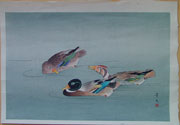Biographical Data
Biography
Matsumura Keibun 景文松村 (1779-1843)
Source: http://www.hkartclub.com/painting/painting252.htmlN. Matsumura Keibun 松村景文 A. Shiso 子藻 F. N. Kaname 耍人 gō. Kakei 華溪 S. Shijō school.
Matsumura Keibun [Kakei]
(b Kyoto, 1779; d Kyoto, 26 May 1843). Japanese painter. He was a leading figure in the Shijō school established by his half-brother, Matsumura Goshun 松村呉春 (1752-1811). Their father, a fourth-generation official of the Kyoto gold mint, died when Keibun was two years old, making it likely that he would follow Goshun, 27 years his senior, into an artistic career. Keibun mastered the techniques of painting taught at Goshun’s studio at Shijō-Sakaimachi in Kyoto. He studied the work of Maruyama Ōkyo 円山応挙 (1733–1795), whose blend of realism and decorative beauty exerted a major influence on him. Keibun’s numerous sketchbooks reveal his lifelong adherence to Ōkyo’s dictum to draw from nature. Additionally, he was familiar with Chinese literati painting (Bunjinga) and art theories of the Ming (1368–1644) and Qing (1644–1911) periods. In his later years he associated with Koishi Genzui 小石元瑞 (1793–1865), a leading figure of Confucian literati circles in Kyoto. In 1797 Keibun’s work was chosen for exhibition by the leading literati scholar and painter, Minagawa Kien 皆川淇園 (1734–1807) who from 1792 sponsored twice-yearly exhibitions of new works of painting. By 1801 his designs were being included with those of Goshun and other Kyoto artists in woodblock-printed picture-books (ehon). After Goshun’s death in 1811 Keibun shared the leadership of the Shijō school with fellow-pupil Okamoto Toyohiko 岡本豊彦 (1773-1845), and the two became the most popular painters in Kyoto. Keibun was particularly noted for his bird-and-flower (kachō) compositions.
